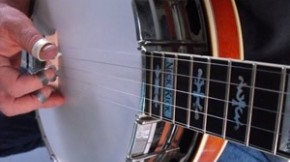Learning to play Chords and Chord Shapes
Practicing chords on banjo
Question:
As I'm practicing chords and my chord progressions on banjo, Should I try to find the chords closest to each other on the neck. or try to pick up and down the neck or try pick different shapes.
I get a little confused trying to pick out say which D to go to
Good question actually. I normally suggest finding the ones closest to each other when you learning and finding them.
My Answer:
Once you master the location and positions, you should experiment with what position sounds best to you.
Here is some really general advice to follow to choose the best sounding and most appropriate chords when playing the progressions (after you know where they all are, and you can switch between them easily)
First a chord is made up of the 1st, 3rd, and 5th note of the scale.
Here is a G scale. 1st G 2nd A 3rd B 4th C 5th D 6th E 7th F# G
A G chord is G B D, the 1st, 3rd, and 5th as indicated above. The root note is G in a G chord, the 1st note of the scale.
Okay, if you understand that, I can throw around the terms, 1st, 3rd and 5th and you should not what I'm talking about.
Now here is that general advice:
The F form is a good place to start and a good place to end. It's also a good place to play the first measure or half measure of C for instance, when the chord changes to C, or when a progression changes to any chord really.
The D Form is best used as a passing chord in between chord changes, or when you are in the middle of the chord progression , (not at the beginning or end of it)
The Bar Form sounds best when you only play the top three strings of it or the top two. The fourth string is not needed as much in the bar form. Remember the 4th and the 1st strings are the same note in the F, D and Bar forms, just an octave apart. I'll explain that a little more below.
When the chord changes to D, you could use the F shaped D at the 10th and 12th fret or the D in the Bar form at the 7th when your in the middle of the progression for instance. The D form D chord works well when the chord D is played right before the G, when the progression is resolving at the end of one time through the song or progression. (which happens in most songs).
These are general suggestions and don't always apply, but it gives you some framework to begin experimenting with. The reason the F form works so well is because there are two root notes of the chord in the shape and if you are vamping, there is a root note on the bottom on the fourth string which sounds good and is very useful.
The reason the D form is not as good a place to start is that there is only one root note in that shape and its on the 2nd string, the 4th and 1st strings are the third note of the scale, basically the F form sounds more like a G chord, then G at the 7th fret in the D form, for instance. However the D form G works very well as a passing chord or in the middle of the progression.
The Bar form works well when playing the top three strings, because you have the three notes of the chord perfectly aligned on the 1st 2nd and 3rd strings, with the root of the chord on the 3rd string, the next chord note, the third, on the 2nd string, and the next chord note, the 5th on the 1st string.
Here is an example of why the Bar form normally sounds better or is more useful just fretting the top three strings. If you fret the 4th string when playing a bar chord, you are playing two 5ths and only one root and the root note gets buried in the sound. It sometimes barely sounds like the chord you are fretting. For instance, when you fret a C in the Bar form at the 5th fret, you have a G on the 4th string and a G on the 1st string, it can almost sound as much like a G chord as a C chord if you are sounding the 1st and 4th strings very loudly. That's a slight exaggeration but hopefully you get my point.
First step, be able to switch between chords easily.
Next step, experiment and use the practical advice above as a framework to get started in choosing the best sounding chords to play when backing up or picking around the chords in a song or progression.
After you've mastered this, learn your seventh chords, and start filtering them in. Seventh chords are an instant embellishment and work well for solos and as backup fills. If you have two measures of G in a song for instance, practice playing the second measure of G in a G7 shape and so on.
Good luck!









